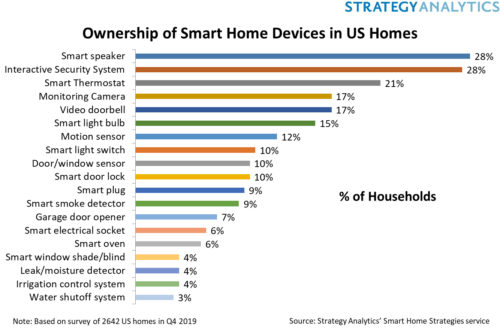54% of US homes now have at least one Smart Home device
Tuesday, January 7th, 2020Strategy Analytics at CES: Most Homes Are Now Smart Homes
- 54% of US Homes Now Own At Least One Smart Home Device
BOSTON — A major new report by Strategy Analytics, released to coincide with this week’s CES in Las Vegas, suggests that smart homes have now become the majority in the US. According to the survey of 2642 respondents in Q4 2019, 54% of homes own at least one smart home device, with the most popular being smart speakers, interactive security systems and smart thermostats. Smart home adopters say that the main reasons for buying into the smart home products are that they are easy to use, very convenient and that they feel more secure.

“After less than a decade as a commercial proposition, the smart home has already passed the tipping point,” comments Bill Ablondi, Director, Smart Home Strategies. “The fact that a majority of people have bought into the smart home shows that there is no going back – the smart home has become the normal home.”
Jack Narcotta, Senior Analyst, adds: “Our research shows that smart home products and services have improved people’s lives by removing some of the familiar frustrations associated with household technologies. Where people find value and convenience in smart technologies they are prepared to invest, and vendors wanting to benefit from this fast growing market need to focus on understanding and addressing those pain points.”
As well as the US, the study researched smart home adoption in France, Germany and the UK. Smart home adoption rates have now reached 50% in the UK, 40% in Germany and 38% in France.
Latest News
- Barb to start reporting TV-set viewing of YouTube channels
- SAT FILM selects multi-DRM from CryptoGuard
- Qvest and ARABSAT to launch OTT streaming platform
- ArabyAds & LG Ad Solutions partner with TVekstra in Turkey
- Freeview NZ satellite TV service to move to Koreasat 6
- Comscore expands YouTube CTV measurement internationally
